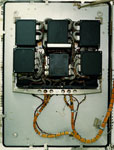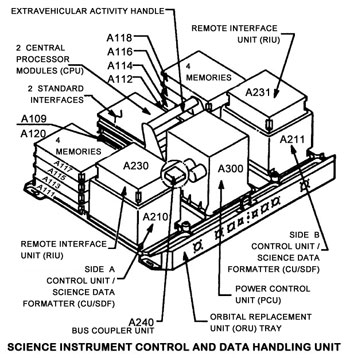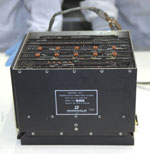|
 The SIC&DH unit keeps all science instrument systems synchronized. It works with the Data Management Unit (DMU) to process, format, temporarily store on the data recorders, or transmit all science and engineering data created by the instruments to the ground.
The SIC&DH unit keeps all science instrument systems synchronized. It works with the Data Management Unit (DMU) to process, format, temporarily store on the data recorders, or transmit all science and engineering data created by the instruments to the ground.
The SIC&DH unit is a collection of electronic components attached to an Orbital Replacement Unit (ORU) tray mounted on the door of Bay 10 in the Support Systems Module (SSM) Equipment Section. Small Remote Interface Units (RIU), also part of the system, provide the interface to individual science instruments. Components of the SIC&DH unit are:
- The NASA Standard Spacecraft Computer, Model-I (NSSC-I)
- Two standard interface circuit boards for the computer
- Two Control Units/Science Data Formatter (CU/SDF) units
- Two CPU modules
- A Power Control Unit (PCU)
- Two Remote Interface Units (RIUs)
- Various memory, data, and command communications lines connected by couplers
(Roll over text above for SIC&DH component identification in graphic below)

The SIC&DH components are redundant so the system can recover from any single failure.
Control Unit/Science Data Formatter (CU/SDF)
 The heart of the SIC&DH unit is the CU/SDF. It formats and sends all commands and data to designated destinations such as the DMU of the SSM, the NSCC-I, and the science instruments. The unit has a microprocessor for control and formatting functions. The heart of the SIC&DH unit is the CU/SDF. It formats and sends all commands and data to designated destinations such as the DMU of the SSM, the NSCC-I, and the science instruments. The unit has a microprocessor for control and formatting functions.
The CU/SDF receives ground commands, data requests, science and engineering data, and system signals. Two examples of system signals are "time tags", clock signals that synchronize the entire spacecraft, and "processor interface tables", or communications codes. The CU/SDF transmits commands and requests after formatting them so that the specific destination unit can read. For example, ground commands and SSM commands are transmitted with different formats. Ground commands use 27-bit words, and SSM commands use 16-bit words. The formatter translates each command signal into a common format. The CU/SDF also reformats and sends engineering and science data.
On September 27, 2008 the failure of the "A" side CU/SDF forced the postponement of the planned October servicing mission into mid-2009. While NASA engineers were able to switch over to the "B" side CU/SDF, they could not leave such an important component unable to recover from a single point failure. Since a spare SIC&DH was available, they wanted to add-on its replacement to the SM4 mission. However, prior to sending the replacement up, it must undergo rigorous testing, the same as any piece of equipment destined for Hubble, which takes months to complete.
|